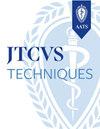Aortic valve repair using aortic wall as leaflet patch material in children
IF 1.9
Q3 CARDIAC & CARDIOVASCULAR SYSTEMS
引用次数: 0
Abstract
Background
Aortic valve repair (AVr) exhibits acceptable outcomes in children with adequate native tissue. With deficient leaflets, patch augmentation is often required. Autologous pericardium (AP) calcification precipitates cusp immobility and high failure rates. Alternatively, the use of aortic wall (AW) as leaflet patch material was assessed.
Methods
Between January 2023 and July 2024, 38 children underwent AVr using bicuspidization (n = 29; 76%) or another technique with AW (n = 19) or AP (n = 19) patches. Concurrent reduction ascending aortoplasty was performed more often in AW (n = 18 [95%] vs 10 [53%] for AP; P = .008). Primary endpoints were AoV reoperation and/or recurrent >mild aortic regurgitation (AR).
Results
Hospital stay, complications, and predischarge reoperation (3 AW, 2 AP) were similar in the 2 groups. There were no deaths in either group. At discharge, the AW and AP groups had a similar rate of >mild AR (19% vs 6%; P = .34), but the AW group had a >30% lower incidence of >trivial AR (25% vs 59% for AP; P = .08). At a median follow-up of 10.2 months, there were no additional reoperations in the AW group but 3 (16%) in the AP group (P = .61). On follow-up echocardiography at a median of 5.4 months, the rate of >mild AR was 23% in the AW group versus 24% in the AP group (P = .59). At 8 months postoperatively, for the AW and AP groups, freedom from reoperation was 84.2% versus 79.0% (P = .61), recurrent >mild AR was 82.8% versus 78.6% (P = .45), and the composite of reoperation and recurrent AR was 68.4 versus 73.7% (P = .61).
Conclusions
Pediatric AVr using AW as leaflet patch material has similar short-term outcomes as AP. Given the potential advantages of using a living autologous cardiovascular material, AW patches for AVr may demonstrate superior valve performance and durability with longer-term follow-up and expand options for valves previously thought to be unrepairable.
应用主动脉壁作为小叶补片材料修复儿童主动脉瓣
背景:主动脉瓣修复(AVr)在具有足够的原生组织的儿童中显示出可接受的结果。对于有缺陷的小叶,通常需要补片。自体心包(AP)钙化沉淀尖不动和高失败率。另外,评估了主动脉壁(AW)作为小叶补片材料的使用。方法在2023年1月至2024年7月期间,38名儿童使用双尖化(n = 29; 76%)或其他技术使用AW (n = 19)或AP (n = 19)贴片进行AVr。同时复位升主动脉成形术在AW患者中更为常见(n = 18 [95%] vs AP患者10 [53%];P = 0.008)。主要终点为主动脉瓣再手术和/或复发性轻度主动脉瓣反流(AR)。结果两组患者住院时间、并发症、出院前再手术(3例AW, 2例AP)相似。两组均无死亡病例。出院时,AW组和AP组有相似的>;轻度AR发生率(19%对6%,P = .34),但AW组有>;轻度AR发生率低>;30%(25%对59%的AP, P = .08)。在中位随访10.2个月时,AW组没有再手术,AP组有3例(16%)再手术(P = 0.61)。在平均5.4个月的随访超声心动图中,AW组的>;轻度AR发生率为23%,AP组为24% (P = 0.59)。术后8个月,AW组和AP组再手术自由率分别为84.2%和79.0% (P = 0.61),复发性和轻度AR分别为82.8%和78.6% (P = 0.45),再手术和复发性AR合并率分别为68.4和73.7% (P = 0.61)。结论:儿科AVr使用AW作为小叶补片材料的短期疗效与AP相似。考虑到使用活体自体心血管材料的潜在优势,AVr的AW补片可能在长期随访中表现出优越的瓣膜性能和耐用性,并扩大了以前认为不可修复的瓣膜的选择。
本文章由计算机程序翻译,如有差异,请以英文原文为准。
求助全文
约1分钟内获得全文
求助全文

 求助内容:
求助内容: 应助结果提醒方式:
应助结果提醒方式:


